Project Evaluation Assignment: Critical Analysis of IT Infrastructure Delivery Project
VerifiedAdded on 2023/06/09
|8
|1976
|172
AI Summary
This report critically analyzes a project that the researcher was a part of earlier with an aim to understand if there were drawbacks and if there are possibilities for making improvements in the way project was approached. The report includes an introduction, organizational context, critical evaluation and analysis, and an action plan with recommendations. The project was related to IT infrastructure delivery for a bank and involved people from different departments. The report highlights the challenges faced by the company and provides recommendations for improvement.
Contribute Materials
Your contribution can guide someone’s learning journey. Share your
documents today.
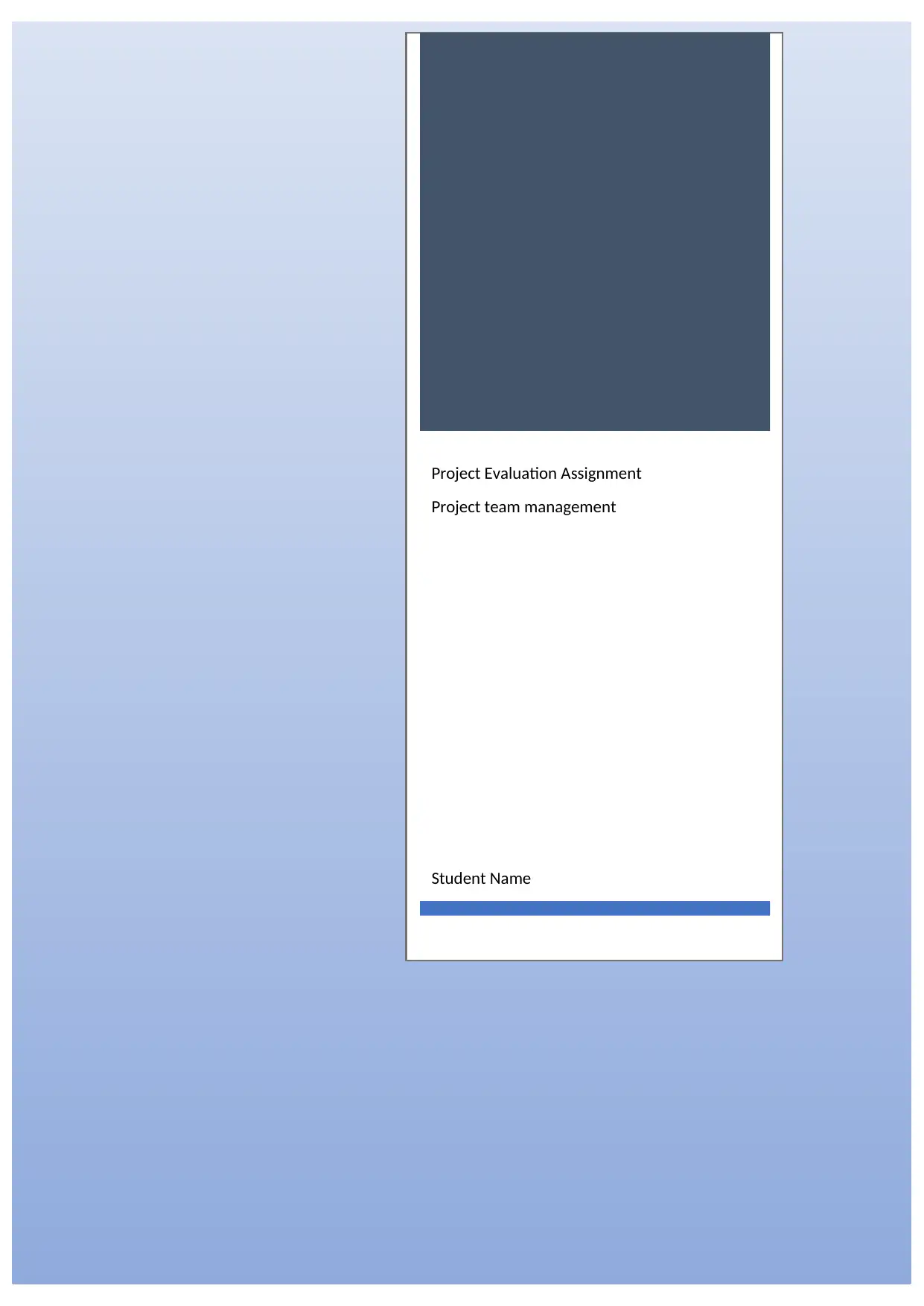
Project Evaluation Assignment
Project team management
Student Name
Project team management
Student Name
Secure Best Marks with AI Grader
Need help grading? Try our AI Grader for instant feedback on your assignments.

Project Evaluation Assignment
1
1

Project Evaluation Assignment
Contents
Introduction................................................................................................................................1
Organisational context...............................................................................................................1
Critical evaluation and analysis.................................................................................................1
action plan and recommendations..............................................................................................2
2
Contents
Introduction................................................................................................................................1
Organisational context...............................................................................................................1
Critical evaluation and analysis.................................................................................................1
action plan and recommendations..............................................................................................2
2
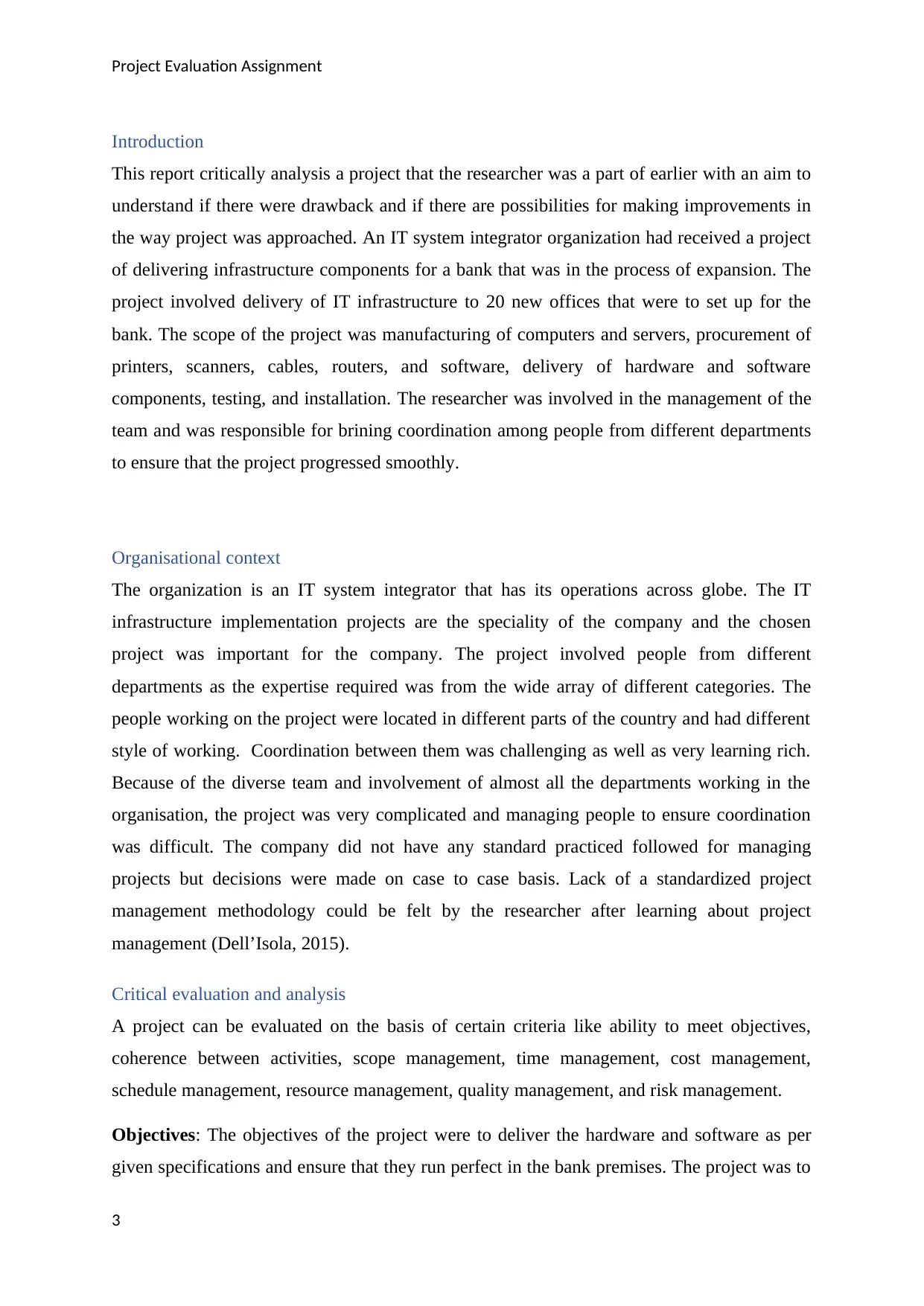
Project Evaluation Assignment
Introduction
This report critically analysis a project that the researcher was a part of earlier with an aim to
understand if there were drawback and if there are possibilities for making improvements in
the way project was approached. An IT system integrator organization had received a project
of delivering infrastructure components for a bank that was in the process of expansion. The
project involved delivery of IT infrastructure to 20 new offices that were to set up for the
bank. The scope of the project was manufacturing of computers and servers, procurement of
printers, scanners, cables, routers, and software, delivery of hardware and software
components, testing, and installation. The researcher was involved in the management of the
team and was responsible for brining coordination among people from different departments
to ensure that the project progressed smoothly.
Organisational context
The organization is an IT system integrator that has its operations across globe. The IT
infrastructure implementation projects are the speciality of the company and the chosen
project was important for the company. The project involved people from different
departments as the expertise required was from the wide array of different categories. The
people working on the project were located in different parts of the country and had different
style of working. Coordination between them was challenging as well as very learning rich.
Because of the diverse team and involvement of almost all the departments working in the
organisation, the project was very complicated and managing people to ensure coordination
was difficult. The company did not have any standard practiced followed for managing
projects but decisions were made on case to case basis. Lack of a standardized project
management methodology could be felt by the researcher after learning about project
management (Dell’Isola, 2015).
Critical evaluation and analysis
A project can be evaluated on the basis of certain criteria like ability to meet objectives,
coherence between activities, scope management, time management, cost management,
schedule management, resource management, quality management, and risk management.
Objectives: The objectives of the project were to deliver the hardware and software as per
given specifications and ensure that they run perfect in the bank premises. The project was to
3
Introduction
This report critically analysis a project that the researcher was a part of earlier with an aim to
understand if there were drawback and if there are possibilities for making improvements in
the way project was approached. An IT system integrator organization had received a project
of delivering infrastructure components for a bank that was in the process of expansion. The
project involved delivery of IT infrastructure to 20 new offices that were to set up for the
bank. The scope of the project was manufacturing of computers and servers, procurement of
printers, scanners, cables, routers, and software, delivery of hardware and software
components, testing, and installation. The researcher was involved in the management of the
team and was responsible for brining coordination among people from different departments
to ensure that the project progressed smoothly.
Organisational context
The organization is an IT system integrator that has its operations across globe. The IT
infrastructure implementation projects are the speciality of the company and the chosen
project was important for the company. The project involved people from different
departments as the expertise required was from the wide array of different categories. The
people working on the project were located in different parts of the country and had different
style of working. Coordination between them was challenging as well as very learning rich.
Because of the diverse team and involvement of almost all the departments working in the
organisation, the project was very complicated and managing people to ensure coordination
was difficult. The company did not have any standard practiced followed for managing
projects but decisions were made on case to case basis. Lack of a standardized project
management methodology could be felt by the researcher after learning about project
management (Dell’Isola, 2015).
Critical evaluation and analysis
A project can be evaluated on the basis of certain criteria like ability to meet objectives,
coherence between activities, scope management, time management, cost management,
schedule management, resource management, quality management, and risk management.
Objectives: The objectives of the project were to deliver the hardware and software as per
given specifications and ensure that they run perfect in the bank premises. The project was to
3
Secure Best Marks with AI Grader
Need help grading? Try our AI Grader for instant feedback on your assignments.
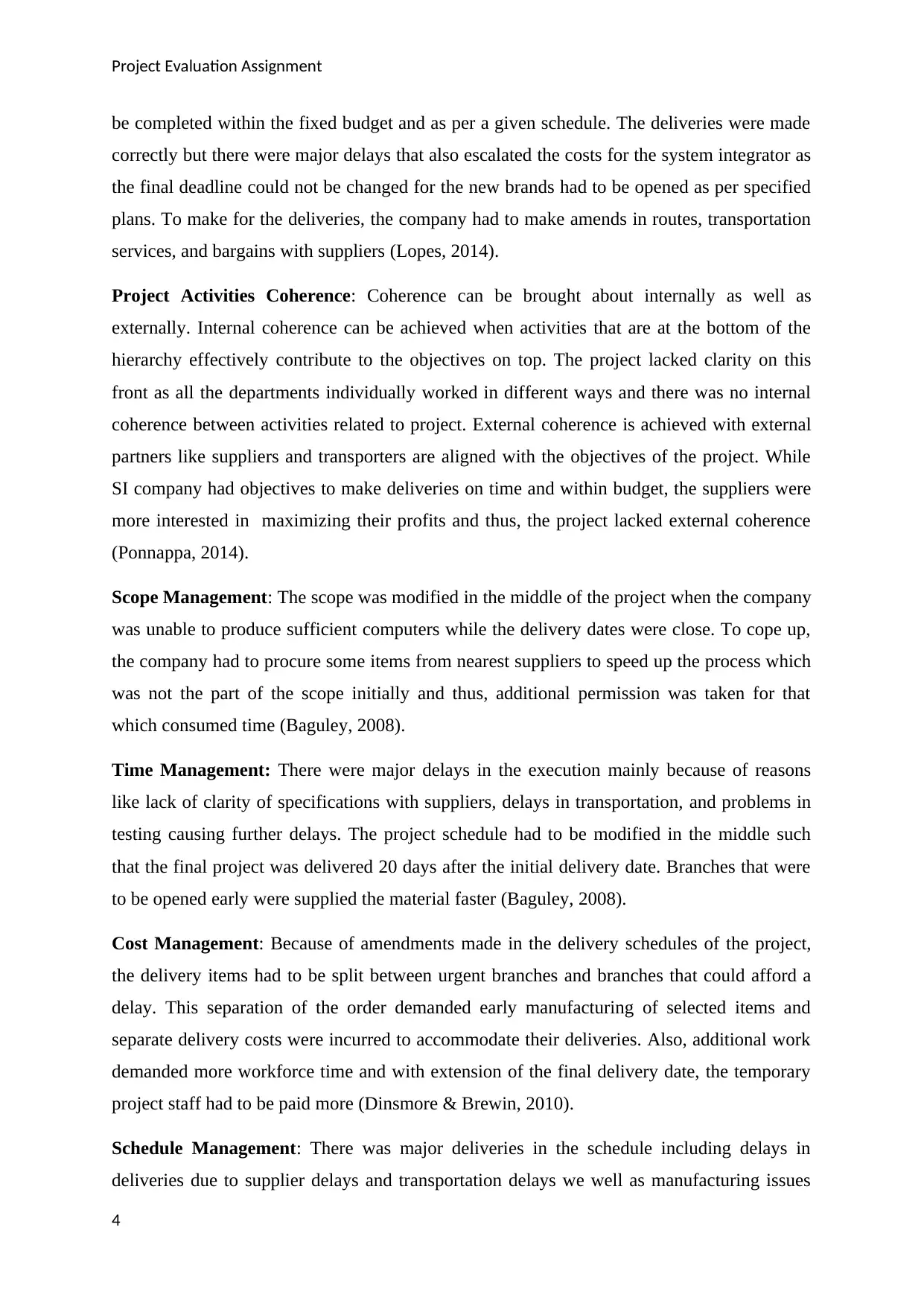
Project Evaluation Assignment
be completed within the fixed budget and as per a given schedule. The deliveries were made
correctly but there were major delays that also escalated the costs for the system integrator as
the final deadline could not be changed for the new brands had to be opened as per specified
plans. To make for the deliveries, the company had to make amends in routes, transportation
services, and bargains with suppliers (Lopes, 2014).
Project Activities Coherence: Coherence can be brought about internally as well as
externally. Internal coherence can be achieved when activities that are at the bottom of the
hierarchy effectively contribute to the objectives on top. The project lacked clarity on this
front as all the departments individually worked in different ways and there was no internal
coherence between activities related to project. External coherence is achieved with external
partners like suppliers and transporters are aligned with the objectives of the project. While
SI company had objectives to make deliveries on time and within budget, the suppliers were
more interested in maximizing their profits and thus, the project lacked external coherence
(Ponnappa, 2014).
Scope Management: The scope was modified in the middle of the project when the company
was unable to produce sufficient computers while the delivery dates were close. To cope up,
the company had to procure some items from nearest suppliers to speed up the process which
was not the part of the scope initially and thus, additional permission was taken for that
which consumed time (Baguley, 2008).
Time Management: There were major delays in the execution mainly because of reasons
like lack of clarity of specifications with suppliers, delays in transportation, and problems in
testing causing further delays. The project schedule had to be modified in the middle such
that the final project was delivered 20 days after the initial delivery date. Branches that were
to be opened early were supplied the material faster (Baguley, 2008).
Cost Management: Because of amendments made in the delivery schedules of the project,
the delivery items had to be split between urgent branches and branches that could afford a
delay. This separation of the order demanded early manufacturing of selected items and
separate delivery costs were incurred to accommodate their deliveries. Also, additional work
demanded more workforce time and with extension of the final delivery date, the temporary
project staff had to be paid more (Dinsmore & Brewin, 2010).
Schedule Management: There was major deliveries in the schedule including delays in
deliveries due to supplier delays and transportation delays we well as manufacturing issues
4
be completed within the fixed budget and as per a given schedule. The deliveries were made
correctly but there were major delays that also escalated the costs for the system integrator as
the final deadline could not be changed for the new brands had to be opened as per specified
plans. To make for the deliveries, the company had to make amends in routes, transportation
services, and bargains with suppliers (Lopes, 2014).
Project Activities Coherence: Coherence can be brought about internally as well as
externally. Internal coherence can be achieved when activities that are at the bottom of the
hierarchy effectively contribute to the objectives on top. The project lacked clarity on this
front as all the departments individually worked in different ways and there was no internal
coherence between activities related to project. External coherence is achieved with external
partners like suppliers and transporters are aligned with the objectives of the project. While
SI company had objectives to make deliveries on time and within budget, the suppliers were
more interested in maximizing their profits and thus, the project lacked external coherence
(Ponnappa, 2014).
Scope Management: The scope was modified in the middle of the project when the company
was unable to produce sufficient computers while the delivery dates were close. To cope up,
the company had to procure some items from nearest suppliers to speed up the process which
was not the part of the scope initially and thus, additional permission was taken for that
which consumed time (Baguley, 2008).
Time Management: There were major delays in the execution mainly because of reasons
like lack of clarity of specifications with suppliers, delays in transportation, and problems in
testing causing further delays. The project schedule had to be modified in the middle such
that the final project was delivered 20 days after the initial delivery date. Branches that were
to be opened early were supplied the material faster (Baguley, 2008).
Cost Management: Because of amendments made in the delivery schedules of the project,
the delivery items had to be split between urgent branches and branches that could afford a
delay. This separation of the order demanded early manufacturing of selected items and
separate delivery costs were incurred to accommodate their deliveries. Also, additional work
demanded more workforce time and with extension of the final delivery date, the temporary
project staff had to be paid more (Dinsmore & Brewin, 2010).
Schedule Management: There was major deliveries in the schedule including delays in
deliveries due to supplier delays and transportation delays we well as manufacturing issues
4
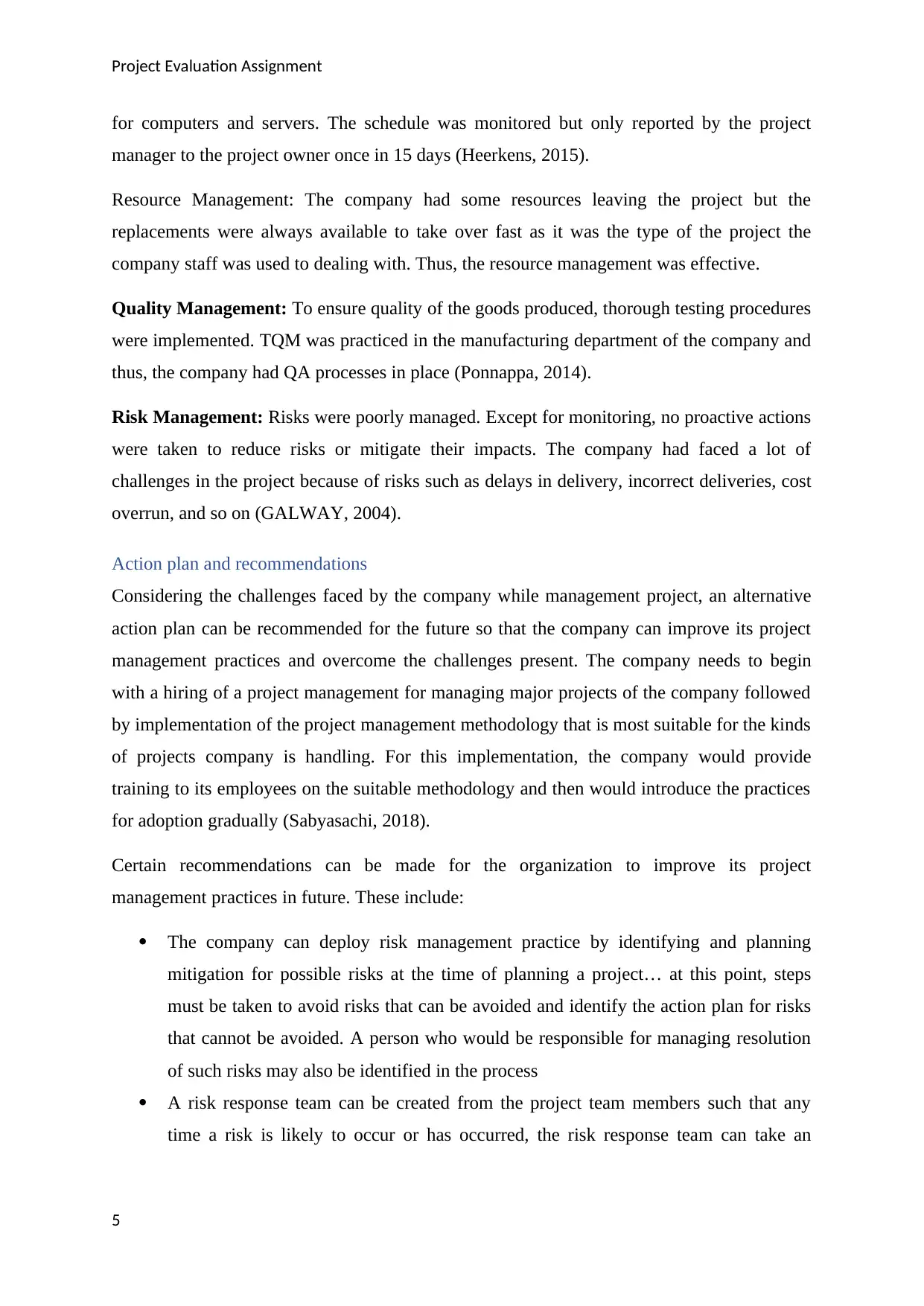
Project Evaluation Assignment
for computers and servers. The schedule was monitored but only reported by the project
manager to the project owner once in 15 days (Heerkens, 2015).
Resource Management: The company had some resources leaving the project but the
replacements were always available to take over fast as it was the type of the project the
company staff was used to dealing with. Thus, the resource management was effective.
Quality Management: To ensure quality of the goods produced, thorough testing procedures
were implemented. TQM was practiced in the manufacturing department of the company and
thus, the company had QA processes in place (Ponnappa, 2014).
Risk Management: Risks were poorly managed. Except for monitoring, no proactive actions
were taken to reduce risks or mitigate their impacts. The company had faced a lot of
challenges in the project because of risks such as delays in delivery, incorrect deliveries, cost
overrun, and so on (GALWAY, 2004).
Action plan and recommendations
Considering the challenges faced by the company while management project, an alternative
action plan can be recommended for the future so that the company can improve its project
management practices and overcome the challenges present. The company needs to begin
with a hiring of a project management for managing major projects of the company followed
by implementation of the project management methodology that is most suitable for the kinds
of projects company is handling. For this implementation, the company would provide
training to its employees on the suitable methodology and then would introduce the practices
for adoption gradually (Sabyasachi, 2018).
Certain recommendations can be made for the organization to improve its project
management practices in future. These include:
The company can deploy risk management practice by identifying and planning
mitigation for possible risks at the time of planning a project… at this point, steps
must be taken to avoid risks that can be avoided and identify the action plan for risks
that cannot be avoided. A person who would be responsible for managing resolution
of such risks may also be identified in the process
A risk response team can be created from the project team members such that any
time a risk is likely to occur or has occurred, the risk response team can take an
5
for computers and servers. The schedule was monitored but only reported by the project
manager to the project owner once in 15 days (Heerkens, 2015).
Resource Management: The company had some resources leaving the project but the
replacements were always available to take over fast as it was the type of the project the
company staff was used to dealing with. Thus, the resource management was effective.
Quality Management: To ensure quality of the goods produced, thorough testing procedures
were implemented. TQM was practiced in the manufacturing department of the company and
thus, the company had QA processes in place (Ponnappa, 2014).
Risk Management: Risks were poorly managed. Except for monitoring, no proactive actions
were taken to reduce risks or mitigate their impacts. The company had faced a lot of
challenges in the project because of risks such as delays in delivery, incorrect deliveries, cost
overrun, and so on (GALWAY, 2004).
Action plan and recommendations
Considering the challenges faced by the company while management project, an alternative
action plan can be recommended for the future so that the company can improve its project
management practices and overcome the challenges present. The company needs to begin
with a hiring of a project management for managing major projects of the company followed
by implementation of the project management methodology that is most suitable for the kinds
of projects company is handling. For this implementation, the company would provide
training to its employees on the suitable methodology and then would introduce the practices
for adoption gradually (Sabyasachi, 2018).
Certain recommendations can be made for the organization to improve its project
management practices in future. These include:
The company can deploy risk management practice by identifying and planning
mitigation for possible risks at the time of planning a project… at this point, steps
must be taken to avoid risks that can be avoided and identify the action plan for risks
that cannot be avoided. A person who would be responsible for managing resolution
of such risks may also be identified in the process
A risk response team can be created from the project team members such that any
time a risk is likely to occur or has occurred, the risk response team can take an
5
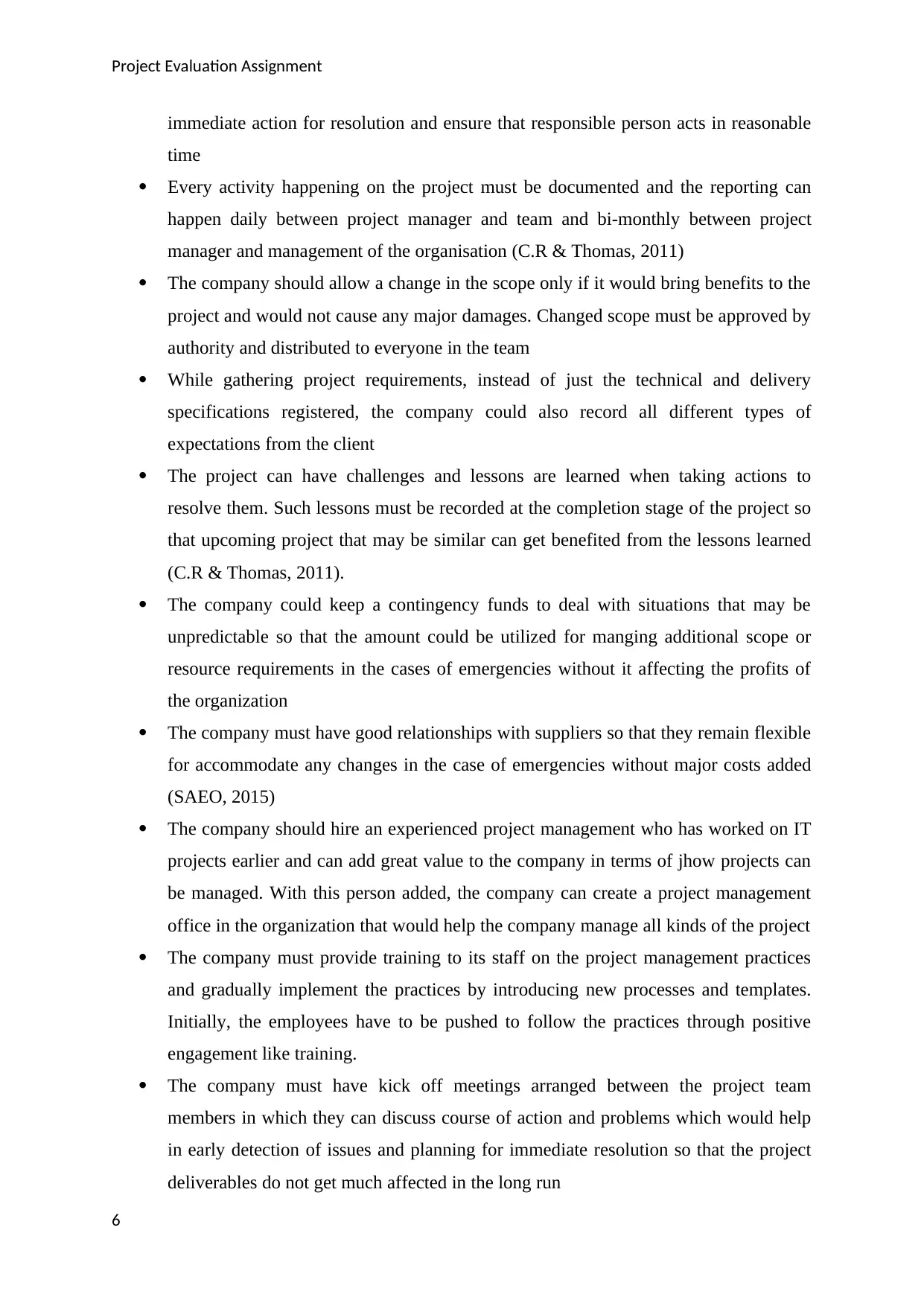
Project Evaluation Assignment
immediate action for resolution and ensure that responsible person acts in reasonable
time
Every activity happening on the project must be documented and the reporting can
happen daily between project manager and team and bi-monthly between project
manager and management of the organisation (C.R & Thomas, 2011)
The company should allow a change in the scope only if it would bring benefits to the
project and would not cause any major damages. Changed scope must be approved by
authority and distributed to everyone in the team
While gathering project requirements, instead of just the technical and delivery
specifications registered, the company could also record all different types of
expectations from the client
The project can have challenges and lessons are learned when taking actions to
resolve them. Such lessons must be recorded at the completion stage of the project so
that upcoming project that may be similar can get benefited from the lessons learned
(C.R & Thomas, 2011).
The company could keep a contingency funds to deal with situations that may be
unpredictable so that the amount could be utilized for manging additional scope or
resource requirements in the cases of emergencies without it affecting the profits of
the organization
The company must have good relationships with suppliers so that they remain flexible
for accommodate any changes in the case of emergencies without major costs added
(SAEO, 2015)
The company should hire an experienced project management who has worked on IT
projects earlier and can add great value to the company in terms of jhow projects can
be managed. With this person added, the company can create a project management
office in the organization that would help the company manage all kinds of the project
The company must provide training to its staff on the project management practices
and gradually implement the practices by introducing new processes and templates.
Initially, the employees have to be pushed to follow the practices through positive
engagement like training.
The company must have kick off meetings arranged between the project team
members in which they can discuss course of action and problems which would help
in early detection of issues and planning for immediate resolution so that the project
deliverables do not get much affected in the long run
6
immediate action for resolution and ensure that responsible person acts in reasonable
time
Every activity happening on the project must be documented and the reporting can
happen daily between project manager and team and bi-monthly between project
manager and management of the organisation (C.R & Thomas, 2011)
The company should allow a change in the scope only if it would bring benefits to the
project and would not cause any major damages. Changed scope must be approved by
authority and distributed to everyone in the team
While gathering project requirements, instead of just the technical and delivery
specifications registered, the company could also record all different types of
expectations from the client
The project can have challenges and lessons are learned when taking actions to
resolve them. Such lessons must be recorded at the completion stage of the project so
that upcoming project that may be similar can get benefited from the lessons learned
(C.R & Thomas, 2011).
The company could keep a contingency funds to deal with situations that may be
unpredictable so that the amount could be utilized for manging additional scope or
resource requirements in the cases of emergencies without it affecting the profits of
the organization
The company must have good relationships with suppliers so that they remain flexible
for accommodate any changes in the case of emergencies without major costs added
(SAEO, 2015)
The company should hire an experienced project management who has worked on IT
projects earlier and can add great value to the company in terms of jhow projects can
be managed. With this person added, the company can create a project management
office in the organization that would help the company manage all kinds of the project
The company must provide training to its staff on the project management practices
and gradually implement the practices by introducing new processes and templates.
Initially, the employees have to be pushed to follow the practices through positive
engagement like training.
The company must have kick off meetings arranged between the project team
members in which they can discuss course of action and problems which would help
in early detection of issues and planning for immediate resolution so that the project
deliverables do not get much affected in the long run
6
Paraphrase This Document
Need a fresh take? Get an instant paraphrase of this document with our AI Paraphraser
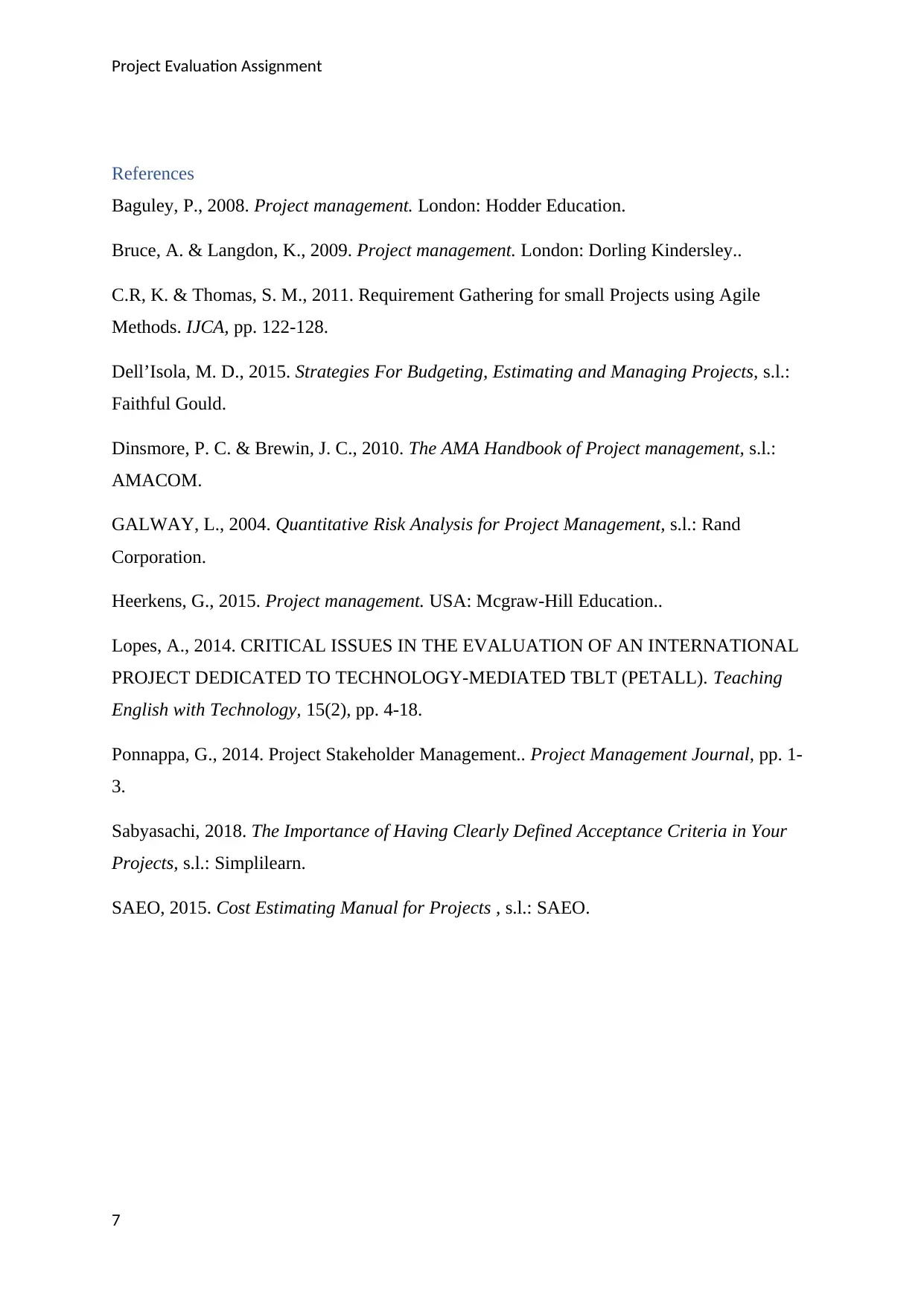
Project Evaluation Assignment
References
Baguley, P., 2008. Project management. London: Hodder Education.
Bruce, A. & Langdon, K., 2009. Project management. London: Dorling Kindersley..
C.R, K. & Thomas, S. M., 2011. Requirement Gathering for small Projects using Agile
Methods. IJCA, pp. 122-128.
Dell’Isola, M. D., 2015. Strategies For Budgeting, Estimating and Managing Projects, s.l.:
Faithful Gould.
Dinsmore, P. C. & Brewin, J. C., 2010. The AMA Handbook of Project management, s.l.:
AMACOM.
GALWAY, L., 2004. Quantitative Risk Analysis for Project Management, s.l.: Rand
Corporation.
Heerkens, G., 2015. Project management. USA: Mcgraw-Hill Education..
Lopes, A., 2014. CRITICAL ISSUES IN THE EVALUATION OF AN INTERNATIONAL
PROJECT DEDICATED TO TECHNOLOGY-MEDIATED TBLT (PETALL). Teaching
English with Technology, 15(2), pp. 4-18.
Ponnappa, G., 2014. Project Stakeholder Management.. Project Management Journal, pp. 1-
3.
Sabyasachi, 2018. The Importance of Having Clearly Defined Acceptance Criteria in Your
Projects, s.l.: Simplilearn.
SAEO, 2015. Cost Estimating Manual for Projects , s.l.: SAEO.
7
References
Baguley, P., 2008. Project management. London: Hodder Education.
Bruce, A. & Langdon, K., 2009. Project management. London: Dorling Kindersley..
C.R, K. & Thomas, S. M., 2011. Requirement Gathering for small Projects using Agile
Methods. IJCA, pp. 122-128.
Dell’Isola, M. D., 2015. Strategies For Budgeting, Estimating and Managing Projects, s.l.:
Faithful Gould.
Dinsmore, P. C. & Brewin, J. C., 2010. The AMA Handbook of Project management, s.l.:
AMACOM.
GALWAY, L., 2004. Quantitative Risk Analysis for Project Management, s.l.: Rand
Corporation.
Heerkens, G., 2015. Project management. USA: Mcgraw-Hill Education..
Lopes, A., 2014. CRITICAL ISSUES IN THE EVALUATION OF AN INTERNATIONAL
PROJECT DEDICATED TO TECHNOLOGY-MEDIATED TBLT (PETALL). Teaching
English with Technology, 15(2), pp. 4-18.
Ponnappa, G., 2014. Project Stakeholder Management.. Project Management Journal, pp. 1-
3.
Sabyasachi, 2018. The Importance of Having Clearly Defined Acceptance Criteria in Your
Projects, s.l.: Simplilearn.
SAEO, 2015. Cost Estimating Manual for Projects , s.l.: SAEO.
7
1 out of 8
Related Documents
Your All-in-One AI-Powered Toolkit for Academic Success.
+13062052269
info@desklib.com
Available 24*7 on WhatsApp / Email
![[object Object]](/_next/static/media/star-bottom.7253800d.svg)
Unlock your academic potential
© 2024 | Zucol Services PVT LTD | All rights reserved.



